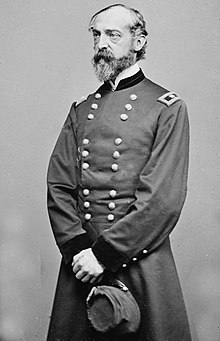 |
| General George Gordon Meade |
HEADQUARTERS ARMY OF THE POTOMAC,
July 28, 1863-3 p. m. {Received 7. 35 p. m. }
Major General H. W. HALLECK,
General-in-Chief:
I am making every effort to prepare this army for an advance. The principal difficulties encountered are the passage of the Rappahannock {at present unfordable, but which will probably be bridged to-night) also the want of animals for the batteries and cavalry, to supply which the quartermaster's department is doing everything possible. The recent marches in the mountain passes and the excessive heat of the weather caused a great loss of animals and the exhaustion of many others. A large proportion of the animals require shoeing. It is also necessary to accumulate subsistence stores to load the trains before starting. I am in hopes to commence the movement tomorrow, when I shall first throw over a cavalry force to feel for the enemy, and cross the infantry as fast as possible. My plan is to advance on the railroad to Culpeper and as far beyond as the enemy's positions will permit, to detach sufficient force to hold and guard the railroad from Manassas Junction, and thus test the question which has been raised of the capacity of the Orange and Alexandria Railroad to supply the army and the practicability of maintaining open such a long line of communication.
No reliable intelligence of the position of the enemy has been obtained. He pickets the Rappahannock from Fredericksburg to Rappahannock Station. These pickets, however, seem to be mere "lookouts, " to warn him of my approach. Some camps can be seen at Pony Mountain, near Culpeper, and in the vicinity of Cedar Mountain. Contradictory reports from citizens and scouts place the main body, some at Gordonsville, others say at Staunton and Charlottesville, and some assert the retreat has been extended to Richmond. My own expectation is that he will be found behind the line of defense, most of the fords being commanded by the southern bank, where his artillery can be used to advantage. If I can hold the railroad without too great a weakening of my force, and it proves to have the capacity to afford all the supplies needed, I shall advance until the enemy is encountered or definite information obtained of his movements. By holding the road, I do not refer to the force necessary to prevent the injuries caused by guerrillas, but against large bodies of cavalry or other forces placed on my flank and rear for the purpose of destroying my communications.
GEO. G. MEADE,
Major-General.
P. S.-4 p. m. -A scout just returned from across the river reports the enemy have repaired the railroad bridge across the Rapidan, and are using the road to Culpeper Court-House; that Lee has been intends to make a stand at Culpeper or in its vicinity.
Official Records, Series I., Vol. 27, Part 1, Page 105.
Meade believed himself under pressure from Lincoln to advance and attack Lee. But the logistics of moving so many men over a considerable distance after a major battle worked against him, as did the current stage of the Rappahannock River. It is interesting to note Lincoln's excitement by this time had cooled and he was not, in fact, urging Halleck to spur Meade to attack. But there remained a lack of communication between Meade and Lincoln, perhaps because Meade was the least politically inclined of the generals who to this point had commanded the Army of the Potomac.
No comments:
Post a Comment